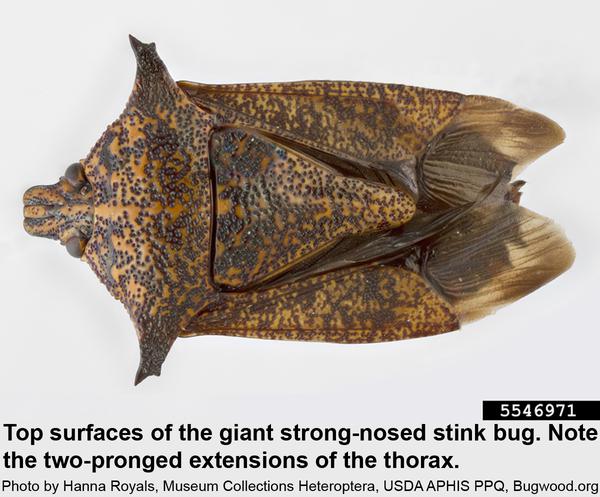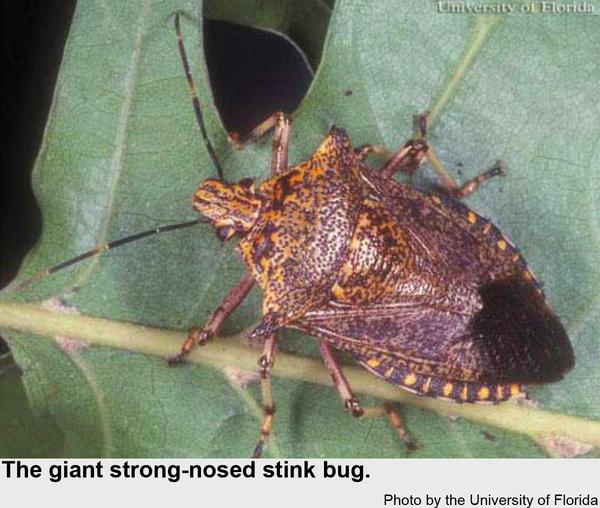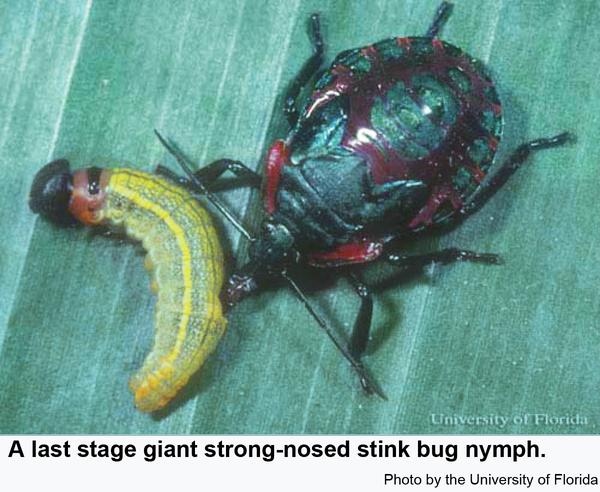Description and Biology
The giant strong-nosed stink bug, Alcaeorrhynchus grandis, is our largest stink bug (3/4 to 1 inch long). These large, flat bugs are speckled brown, with a double-pointed extension on each "shoulder," and they have a short stabbing beak. The ends of the top wings noticeably lack speckles and are corrugated with veins, are shinier, and are sometimes darker. The top of the abdomen is spotted outside the wings. Eggs are laid 100 to 200 at a time in masses usually arranged in four to five rows. Nymphs are communal and develop through five immature stages that are distinctly different from the parents. Newly hatched nymphs are about 1/16 inch long and are blue-black with red abdomens. Older nymphs are blue-black and red splotched and gradually develop wing buds as they mature. Stage five nymphs are up to 5/8 inch long. All stages (except the eggs) feed on less fortunately insects they encounter although it is likely that in the absence of prey, they may feed on plants. Eggs take 15 or 16 days to hatch and development from egg to adult takes about 2 months. They probably overwinter as adults and older nymphs in North Carolina.
Hosts
Giant strong-nosed stink bugs are often found on soybeans, eggplants, shrubs, and trees usually near streams & marshes where they prey on other insects, especially moth caterpillars.
Residential Recommendations
Giant strong-nosed stink bugs are generally considered to be beneficial in that they feed on plant pests. In the case where these bugs are feeding on catawba worms (catalpa sphinx caterpillars) prized as fish bait, little can be done other than removing the bugs by hand and dropping them in soapy water. Any insecticide applied to kill the bugs is likely to kill the caterpillars as well.
Other Resources
- Predatory Stink Bug, Scientific Name: Alcaeorrhynchus grandis (sic) (Dallas) (Hemiptera: Pentatomidae). Richman, D. B. and F. W. Mead. 2025 (released). askifas powered by EDIS. Publication Number: EENY-165.
- Species Alcaeorrhynchus grandis - Giant Strong-nosed Stink Bug. Nendick-Mason, H. et al. 2020 (update). BugGuide, Department of Entomology, Iowa State University.
- NC State Extension Plant Pathology Publications
- NC State Extension Horticultural Science Publications
- North Carolina Agricultural Chemicals Manual
For assistance with a specific problem, contact your local Cooperative Extension center.
This factsheet has not been peer reviewed.
Publication date: Jan. 27, 2021
Reviewed/Revised: Nov. 26, 2025
Recommendations for the use of agricultural chemicals are included in this publication as a convenience to the reader. The use of brand names and any mention or listing of commercial products or services in this publication does not imply endorsement by NC State University or N.C. A&T State University nor discrimination against similar products or services not mentioned. Individuals who use agricultural chemicals are responsible for ensuring that the intended use complies with current regulations and conforms to the product label. Be sure to obtain current information about usage regulations and examine a current product label before applying any chemical. For assistance, contact your local N.C. Cooperative Extension county center.
N.C. Cooperative Extension prohibits discrimination and harassment regardless of age, color, disability, family and marital status, gender identity, national origin, political beliefs, race, religion, sex (including pregnancy), sexual orientation and veteran status.




